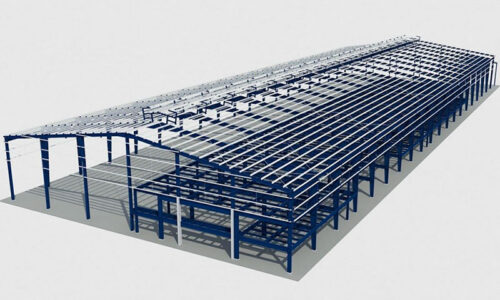THE ADVANTAGES AND APPLICATIONS OF STEEL STRUCTURES IN CONSTRUCTION
Introduction: Steel structures have become increasingly popular in the construction industry due to their numerous advantages and wide range of applications. Steel is a versatile and durable material that offers significant benefits in terms of strength, flexibility, and cost-effectiveness. This article explores the advantages of steel structures and highlights their various applications in construction projects.
Advantages of Steel Structures:
- Strength and Durability: One of the key advantages of steel structures is their exceptional strength and durability. Steel has a high tensile strength, allowing it to withstand heavy loads and resist deformation. It is also highly resistant to corrosion, fire, and pests, making it a long-lasting and reliable material for construction.
- Design Flexibility: Steel structures offer tremendous design flexibility, enabling architects and engineers to create innovative and aesthetically pleasing buildings. Steel can be easily shaped and molded into various forms, allowing for complex architectural designs and unique structural configurations. This flexibility makes steel structures ideal for iconic landmarks, such as bridges, stadiums, and skyscrapers.
- Speed of Construction: Steel structures can be erected quickly and efficiently, significantly reducing construction time compared to traditional building materials. Steel components are prefabricated off-site, ensuring high precision and quality control. The quick assembly of steel structures translates into shorter project schedules, faster occupancy, and reduced labor costs.
- Cost-Effectiveness: While steel may have a higher initial cost than other construction materials, its long-term cost-effectiveness is evident. Steel structures require minimal maintenance, have a longer lifespan, and offer excellent energy efficiency. Additionally, the speed of construction reduces labor and financing costs, making steel structures a cost-effective choice in the long run.
- Sustainable and Recyclable: Steel is an environmentally friendly material as it is 100% recyclable. Steel structures can be disassembled and reused in other projects, minimizing waste and reducing the demand for new raw materials. Furthermore, steel manufacturing processes have become more energy-efficient, reducing greenhouse gas emissions and promoting sustainability.
Applications of Steel Structures:
- Commercial Buildings: Steel structures are widely used in the construction of commercial buildings, such as office complexes, shopping malls, and warehouses. The open floor plans and long spans achievable with steel allow for flexible interior layouts and maximize usable space.
- Industrial Facilities: Steel structures are the preferred choice for industrial facilities, including factories, power plants, and refineries. The strength and durability of steel can withstand heavy machinery, equipment, and extreme operating conditions. Steel also provides a safe and secure environment for industrial operations.
- Bridges and Infrastructure: Steel is extensively used in the construction of bridges and infrastructure projects due to its high strength-to-weight ratio. Steel bridges offer superior load-bearing capacity, durability, and resistance to harsh environmental conditions. Steel is also used in the construction of tunnels, railway stations, and airport terminals.
- High-Rise Buildings: The remarkable strength of steel makes it an ideal material for constructing high-rise buildings and skyscrapers. Steel structures provide the necessary stability, flexibility, and safety required in tall structures. The lightweight nature of steel reduces the overall building weight and allows for efficient foundation systems.
- Residential Buildings: Steel structures are increasingly being employed in residential construction. Steel-framed houses offer advantages such as enhanced design possibilities, faster construction, and improved resistance to natural disasters. The use of steel in residential buildings ensures structural integrity and reduces the risk of damage during earthquakes or hurricanes.
Conclusion: Steel structures have revolutionized the construction industry by offering numerous advantages and diverse applications. The strength, durability, design flexibility, and cost-effectiveness of steel make it an ideal choice for a wide range of projects, from commercial and industrial buildings to bridges and residential structures. As technology and innovation continue to advance, steel will likely remain a vital component in the construction industry, contributing to safer, sustainable, and visually appealing structures.


